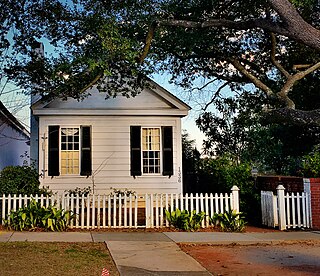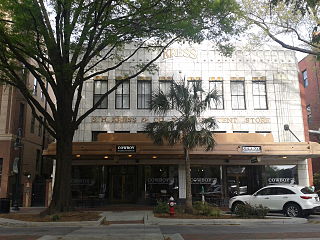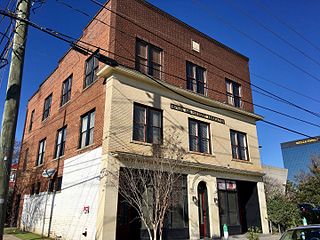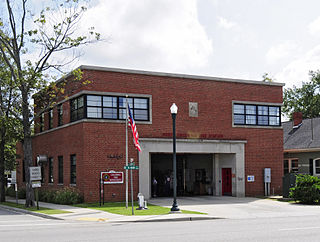Exchange Bank or Exchange Bank Building may refer to:

The Zimmerman School is a historic school building located at Columbia, South Carolina. It was built in 1848, and is a small Greek Revival style one-story clapboard building with a gable roof. The school was built by Charles and Hannah Zimmerman, who operated it from 1848 to 1870, and also built the neighboring Zimmerman House.

Debruhl-Marshall House is a historic home located in Columbia, South Carolina. It was built in 1820, and is a two-story, five bay, brick Greek Revival style dwelling. It has a gabled slate roof and full basement. The front facade features a three bay portico supported by four massive Doric order columns.

Sylvan Building, originally known as Central National Bank, is a historic commercial building located at Columbia, South Carolina. It was built in 1870, and is a three-story, brick Second Empire style building designed by Samuel Sloan. It features a slate-covered mansard roof.

Town Theatre is a historic community theatre located at Columbia, South Carolina. It was built in 1924, and is a rectangular brick building with a two-story glazed central arch with Art Deco influences. A brick annex was added to the rear of the building in the 1950s. It houses one of the first community theatres in the United States.

Building at 1210-1214 Main Street, also known as Capitol Café, is a historic commercial building located at Columbia, South Carolina. It was built by 1871, and is a two-story, seven bay, stuccoed brick building. A cast-iron railing extends across central three bays of the second floor. The Capitol Café has been located in the building since 1913.

The Building at 1644 Main Street, also known as Tapp's Department Store, is a historic commercial building located at Columbia, South Carolina. It was built in 1940, and enlarged in 1950. It is a five- to seven-story, Depression Modern building faced in stucco and dark tremolite stone. Above the main entrance is a distinctive clock face and a sign with large freestanding letters. Tapp's Department Store closed in 1995.

Lever Building is a historic commercial building located at Columbia, South Carolina. It was built in 1903, and is a three-story building faced with brown brick and terra cotta.

Kress Building is a historic commercial building located at Columbia, South Carolina. It was built in 1934 by S. H. Kress & Co., and is a two-story, Art Deco style building faced with white terra cotta and colored terra cotta ornamentation. It features rounded storefront windows and cornice that contains the word "Kress" and surmounted by a stepped parapet.

First National Bank, also known as the National Loan and Exchange Bank Addition, is a historic bank building located at Columbia, South Carolina. It was built about 1924, and is a two-story, stone faced Neoclassical style building consisting of a two-story central section with flanking one-story wings. The front façade features four monumental 3/4 detached Doric order columns.

Canal Dime Savings Bank, also known as Eckerd's Drug Store, is a historic bank building located at Columbia, South Carolina. It was built between 1892 and 1895, and is a three-story, Romanesque Revival style brick building with a granite façade and red barrel tile roof. The building was purchased by Eckerd's Drug Store in 1936.

North Carolina Mutual Building, also known as the Blue Palace Tea Shop and Barber Shop, is a historic commercial building located at Columbia, South Carolina. It was built in 1909 by the North Carolina Mutual Life Insurance Company, and is a three-story, rectangular, brick commercial block. The building housed African-American businesses, professionals, and institutions during the years of Jim Crow segregation. It is located in the Washington Street business district, the city's black downtown.

Richland Cotton Mill, also known as Pacific Mills, Lowenstein Mill, and Whaley's Mill, is a historic cotton mill building located at Columbia, South Carolina. It was built in 1894, and is a four-story, rectangular brick mill building. It features a seven-story stair tower, with a circular vent flanked by two arched vents. Attached to the building are an engine room, a boiler room with chimney, and a machine shop.

Palmetto Compress and Warehouse Company Building is a historic cotton bale compress facility and warehouse building located at Columbia, South Carolina. The first section of the four-story brick building was built in 1917. The building was doubled in size in 1923.

North Columbia Fire Station No. 7 is a historic fire station located at Columbia, South Carolina. It was built in 1948, and is a two-story, brick, transitional Art Moderne / International style building. It features metal window frames, flat roof, and corner ribbon windows.

Pacific Community Association Building, also known as Pacific Community YMCA and The 'Y', is a historic community center located at Columbia, South Carolina. The original section was built in 1903, and is a large two-story, irregularly-shaped brick building. It was enlarged around 1918 with the addition of the pool building, and a large gymnasium in 1923. It provided recreational opportunities for residents of mill villages associated with the Olympia and Granby Mill complex.

Columbia Central Fire Station, also known as Columbia Fire Department Headquarters and Senate Street Station, is a historic fire station located at Columbia, South Carolina. It was built between 1949 and 1951, and consists of two buildings and a structure. The main building is a two-story, rectangular, brick building in the Moderne / International Style. It has a flat roof and features horizontal bands of windows. The one-story, brick fire truck garage building and the main building were constructed in 1949-1950. The drill tower is a six-story reinforced concrete structure built in 1951. The complex served as the Columbia Fire Department's Headquarters from 1950 until 1995.

Granby Mill Village Historic District is a national historic district located at Columbia, South Carolina. The district encompasses 97 contributing buildings associated with a cotton mill and associated mill village. The mill was initially constructed in 1896-1897, and is a large four-story, rectangular brick building in the Romanesque Revival style. It features two projecting five-story entrance towers. The Granby Mill Village includes a number of "saltbox" style dwellings reminiscent of a New England mill village. The district also includes the mill gatehouse, the two-story mill office building, commercial buildings, the Gothic Revival style Whaley Street Methodist Church, and operatives' houses.

Columbia Historic District I is a national historic district located in the Arsenal Hill neighborhood at Columbia, South Carolina. The district encompasses nine contributing buildings and includes a complex of fine mansions and attractive homes built before the American Civil War. The buildings are in the Greek Revival, Italianate, Classical Revival, and the “Columbia Cottage” styles. They include the Governor's Mansion, Caldwell-Hampton-Boylston House, Lace House, and Palmetto Iron Works and Armory.

Columbia Historic District II is a national historic district located at Columbia, South Carolina. The district encompasses 113 contributing buildings and 1 contributing site in a former residential section of Columbia. They were built between the early-19th century and the 1930s and are now mostly used for commercial purposes. The buildings are in the Greek Revival, Gothic Revival, Classical Revival, and the “Columbia Cottage” styles. Notable buildings include the Robert Mills House, Debruhl-Marshall House, Hampton-Preston House, Episcopal Church of the Good Shepherd, Crawford-Clarkson House, Maxcy Gregg House, Hale-Elmore-Seibels House, St. Paul's Lutheran Church, and Ebenezer Lutheran Church.



























